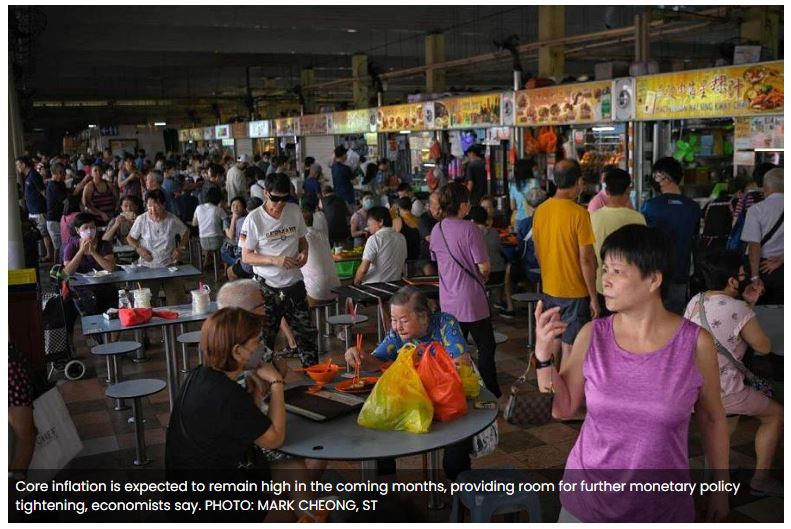Singapore: Economists still expect monetary policy tightening in April
MANY economists continue to expect monetary policy tightening at the Monetary Authority of Singapore’s (MAS) April meeting, after January’s inflation data – released on Thursday (Feb 23) – came in higher than in December. But Barclays economist Brian Tan maintains that there is “little reason to tighten”.
Headline inflation edged up to 6.6 per cent year on year in January, from 6.5 per cent in the previous month, due to higher accommodation inflation and core inflation.
Core inflation, which excludes accommodation and private transport, rose to 5.5 per cent year on year, from 5.1 per cent in December 2022. This was on the back of higher inflation for services, food and retail and other goods, along with the increase in the goods and services tax (GST) rate from 7 per cent to 8 per cent.
Both prints were lower than median estimates of 7.1 per cent for headline inflation and 5.7 per cent core inflation in a Bloomberg poll of economists.
MAS and the Ministry of Trade and Industry said: “The month-on-month step-up in core inflation for January, due in part to the one-off increase in price levels following the GST hike, was expected.” MAS core inflation is expected to stay above 5 per cent year on year in the first quarter, as previously projected, they added.
Core inflation will likely stay elevated in the first half of the year before “slowing more discernibly in H2 2023 as the current tightness in the domestic labour market eases and global inflation moderates”.
The authorities still expect headline inflation to come in at 5.5 to 6.5 per cent and core inflation, 3.5 to 4.5 per cent for the year.
UOB senior economist Alvin Liew noted that with the MAS “pulling only one lever in Oct 2022”, there is still room for further tightening in 2023, particularly if core inflation does not show signs of moderation in coming months.
OCBC chief economist Selena Ling said: “While there may not be immediate urgency to do an off-cycle move for now”, any policy easing would also be premature “until the expected ‘more discernible’ slowdown in core inflation materialises convincingly in H2 2023”.
End-consumers will continue to see higher costs passed on by businesses, emboldened by resilient domestic demand underpinned by healthy labour market conditions, she said.
“The ‘higher for longer’ theme that has been dogging financial markets of late … may also apply here as inflationary pressures are not easing as rapidly as initially hoped for,” she added.
Maybank economists Chua Hak Bin and Lee Ju Ye also expect core inflation to “remain sticky and fall slowly in 2023” partly due to the planned expansion of the Progressive Wage Model to include occupations and more sectors. Core inflation may well exceed the current MAS forecast range for the full year, they said.
Meanwhile, RHB senior economist Barnabas Gan said: “A tighter monetary policy is paramount to anchoring inflation expectations.”
He believes that wage stickiness theory – where wages are inherently sticky due to the infrequent wage adjustments – may keep wage pressures strong.
This is even as inflation momentum eases, without both supply-push drivers – such as easing supply chain frictions – and demand-pull drivers – such as slowing gross domestic product growth momentum and “lacklustre” labour demand in certain sectors.
RHB expects MAS will steepen the Singapore dollar nominal effective exchange rate (S$NEER) gradient to 2 per cent, from the currently estimated 1.5 per cent. OCBC, Maybank and UOB instead expect that the central bank will again re-centre the S$NEER policy mid-point.
In contrast, Barclays’ Tan said that any re-centring “would likely be more for its signalling effect against inflation expectations following the GST hike”. But this is unlikely, since inflation data “suggests the impact of the GST hike has not been unusually large”.
He believes that the likelihood of re-centring is low, since core inflation has been in line with, or possibly even slightly below, MAS’ projections. Tourism recovery, even after accounting for the full return of travellers from mainland China and Hong Kong, is unlikely to significantly boost core inflation.
Additionally, economic growth remains more downbeat than it was in July last year, when MAS began maintaining the slope of the monetary policy band despite re-centring. Thus, a slope increase in 2023 is also unlikely, he added.
Barclays continues to forecast a moderation to 5 per cent for headline inflation and a slight increase in the full-year core-inflation average to 4.2 per cent.
For full-year headline inflation, Maybank (6 per cent), UOB (5 per cent) and OCBC (6 per cent) maintained their projections. Maybank, UOB and OCBC also kept core inflation projections unchanged at 4 per cent.
RHB, however, upgraded its headline and core inflation estimates to 4 per cent, from 3 per cent and 2.8 per cent respectively, on January’s “surprisingly strong” inflation prints, which had exceeded its forecasts.
Source: https://www.businesstimes.com.sg/singapore/economists-still-expect-monetary-policy-tightening-april


 Thailand
Thailand




